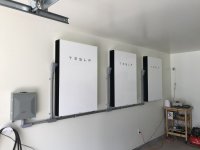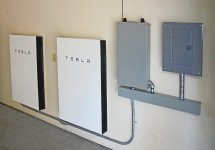Grouch1980
Senior Member
- Location
- New York, NY
I tried looking online for wiring diagrams of multiple Tesla Powerwall 2's connected in parallel, but could only find installation pics, not actual wiring diagrams, such as the following:


My questions are (in an AC coupled method):
1. Doesn't each battery have its own integral multi-mode inverter? If so, are they programmed so that only one of the inverters integral to the battery is the master inverter, and the others follow it (with regards to frequency, timing, etc.)?
2. How is the output wiring of each battery interconnected together? I doubt they are just spliced together. How do they all connect to the backup loads panel?
Thanks.


My questions are (in an AC coupled method):
1. Doesn't each battery have its own integral multi-mode inverter? If so, are they programmed so that only one of the inverters integral to the battery is the master inverter, and the others follow it (with regards to frequency, timing, etc.)?
2. How is the output wiring of each battery interconnected together? I doubt they are just spliced together. How do they all connect to the backup loads panel?
Thanks.

